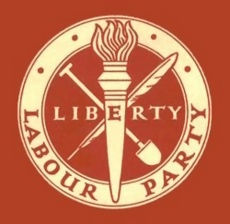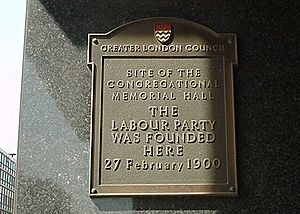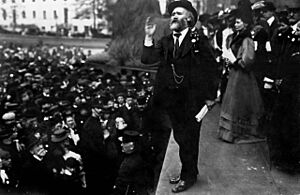Labour Party (UK) facts for kids
Quick facts for kids
Labour Party
|
|
|---|---|
 |
|
| Governing body | National Executive Committee |
| Leader | Keir Starmer |
| Deputy Leader | Angela Rayner |
| General Secretary | David Evans |
| Lords Leader | Angela Smith, Baroness Smith of Basildon |
| Founded | 27 February 1900 (as the Labour Representation Committee) |
| Headquarters |
|
| Youth wing | Young Labour |
| LGBT wing | LGBT+ Labour |
| Membership (March 2024) | |
| Ideology | |
| Political position | Centre-left |
| European affiliation | Party of European Socialists |
| International affiliation | Progressive Alliance Socialist International (observer) |
| Affiliate party | Co-operative Party (Labour and Co-operative) Former affiliates
Independent Labour Party (1906–1932)
British Socialist Party (1916–1920) National Socialist Party (1918–1939/1942) |
| Other affiliations | Social Democratic and Labour Party (Northern Ireland) Gibraltar Socialist Labour Party (Gibraltar) |
| Colours | Red |
| Slogan | "Britain's future" / "Let's get Britain's future back" (2024) |
| Anthem | "The Red Flag" |
| Devolved or semi-autonomous branches |
|
| Parliamentary party | Parliamentary Labour Party (PLP) |
| House of Commons | Parliament dissolved |
| House of Lords |
178 / 777
|
| Scottish Parliament |
22 / 129
|
| Senedd |
30 / 60
|
| Regional mayors |
11 / 12
|
| London Assembly |
11 / 25
|
| PCCs and PFCCs |
17 / 37
|
| Directly elected mayors |
10 / 16
|
| Councillors |
6,561 / 18,646
|
|
|
|
The Labour Party is a major political party in the United Kingdom. It is known for its centre-left ideas. The party brings together people who believe in social democracy, democratic socialism, and trade unions. Since 1922, Labour has always been either the government or the main opposition party.
Six Labour prime ministers have led the UK. There have also been thirteen Labour governments. Since the 2010 general election, Labour has been the second-largest party in the UK by votes. It is behind the Conservative Party and ahead of the Liberal Democrats. The party holds its annual Labour Party Conference during the party conference season.
The Labour Party started in 1900. It grew from the trade union movement and socialist groups of the 1800s. In the 1920s, it became the main rival to the Conservative Party. It took over from the Liberal Party. Labour formed two minority governments in the 1920s and early 1930s. These were led by Ramsay MacDonald.
Labour was part of the government during World War II from 1940 to 1945. After the war, Clement Attlee's Labour government created the National Health Service. They also expanded the welfare state from 1945 to 1951. Under Harold Wilson and James Callaghan, Labour governed again from 1964 to 1970 and from 1974 to 1979. In the 1990s, Tony Blair moved Labour towards the political middle. This was part of his New Labour plan. Labour governed from 1997 to 2010 under Blair and then Gordon Brown.
Today, the Labour Party is the main opposition in the Parliament of the United Kingdom. They won the second-highest number of seats in the 2019 general election. The leader of the party is Keir Starmer. He is also the Leader of the Opposition. Labour is the largest party in the Senedd (Welsh Parliament). It is the only party in the current Welsh government. In the Scottish Parliament, Labour is the third-largest party. It is behind the Scottish National Party and the Scottish Conservatives.
Labour is part of the Party of European Socialists and Progressive Alliance. It is an observer in the Socialist International. The party has branches in London, Scotland, Wales, and Northern Ireland. However, it supports the Social Democratic and Labour Party (SDLP) in Northern Ireland. As of March 2024, Labour has 366,604 members.
Contents
- History
- How the Labour Party Began (1860–1900)
- Forming the Labour Representation Committee (1900–1906)
- Early Years and Growth (1906–1923)
- Labour's First Government and Time in Opposition (1923–1929)
- Labour's Second Government (1929–1931)
- Labour in Opposition (1931–1940)
- Working Together During Wartime (1940–1945)
- The Attlee Government (1945–1951)
- After the War: Labour in Opposition (1951–1964)
- The Wilson Government (1964–1970)
- Labour in Opposition (1970–1974)
- From Majority to Minority (1974–1979)
- Opposition and Internal Challenges (1979–1994)
- New Labour Era (1994–2010)
- Opposition and Recent Challenges (2010–Present)
- What Labour Believes In
- How Labour is Organized
- Election Results
- Party Leaders
- Images for kids
- See Also
History
How the Labour Party Began (1860–1900)
The Labour Party started in the late 1800s. It aimed to represent the growing number of working-class people in cities. Many of these people gained the right to vote in 1884. Some trade union members wanted to get involved in politics. After more people could vote in 1867 and 1885, the Liberal Party supported some candidates backed by trade unions.
Small socialist groups also formed around this time. They wanted to connect their ideas with political action. These groups included the Independent Labour Party (ILP) and the Fabian Society. The Fabian Society was mostly made up of thinkers.
In the 1895 general election, the ILP had 28 candidates. But they only won a small number of votes. Keir Hardie, the ILP leader, believed that different left-wing groups needed to work together.
Forming the Labour Representation Committee (1900–1906)
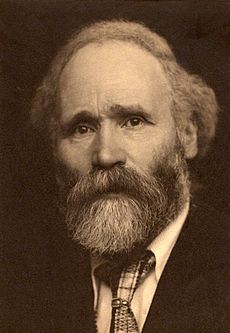
In 1899, a trade union member named Thomas R. Steels suggested a meeting. He wanted all left-wing groups to come together and form one body. This body would support candidates for Parliament. The meeting happened in London in February 1900. Many working-class and left-wing groups attended.
The delegates decided to create the Labour Representation Committee (LRC). Its goal was to help elect Members of Parliament (MPs) who supported working-class people. Ramsay MacDonald was chosen as the Secretary. He had to keep the different groups in the LRC working together. In the 1900 general election, the LRC supported 15 candidates. Two of them won: Keir Hardie and Richard Bell.
Support for the LRC grew after the 1901 Taff Vale Case. In this case, a union had to pay a railway company for damages caused by a strike. This ruling made strikes very risky. It made people see that the government did not care much about working people. This led to more support for the LRC.
In the 1906 general election, the LRC won 29 seats. This was helped by a secret agreement in 1903. Ramsay MacDonald and the Liberal Party agreed not to split votes. This helped both parties against the Conservatives.
After the election, the MPs decided to call themselves "The Labour Party" on February 15, 1906. Keir Hardie was elected as the first Chairman of the Parliamentary Labour Party. This was like being the leader. In its early years, the Independent Labour Party (ILP) provided many activists. The Fabian Society provided many of the party's ideas. One of the first things the new Liberal Government did was to reverse the Taff Vale ruling.
The People's History Museum in Manchester keeps the records of the first Labour Party meeting. They are on display in the museum. The museum also has the Labour History Archive and Study Centre. This holds many Labour Party documents from 1900 to today.
Early Years and Growth (1906–1923)
In 1907, the party held its first annual meeting in Belfast. During this meeting, a question came up: who had more power? Was it the annual meeting or the Labour MPs in Parliament? Keir Hardie threatened to resign over a vote about women's right to vote. This led to a rule that MPs could vote as they wished on some issues.
In the December 1910 election, 42 Labour MPs were elected. This was a big win. A year before, a court ruling had made it harder for trade unions to fund Labour. But by 1913, the government changed the law. This allowed unions to fund Labour MPs more easily.
During World War I, the Labour Party was divided. Some supported the war, others did not. Ramsay MacDonald, who was against the war, resigned as leader. Arthur Henderson became the main leader. He joined Prime Minister H. H. Asquith's government. This made him the first Labour member to serve in government.
After World War I, Henderson focused on building local support for Labour. In 1918, he created a national network of local groups. These groups were separate from unions and open to anyone who supported Labour. Henderson also helped create "Labour and the New Social Order." This document outlined Labour's policies. It called for a guaranteed minimum living standard, nationalisation of industries, and high taxes on large incomes. In 1918, Clause IV was added to Labour's rules. It committed the party to "common ownership of the means of production, distribution and exchange."
The Representation of the People Act 1918 gave almost all adult men and most women over thirty the right to vote. This greatly increased the number of voters. This helped Labour gain more seats in Parliament. The Liberal Party also became weaker. This allowed Labour to gain much of their support. In 1922, Labour won 142 seats. This made them the second-largest group in Parliament and the main opposition. Ramsay MacDonald became the first official leader of the Labour Party.
Labour's First Government and Time in Opposition (1923–1929)
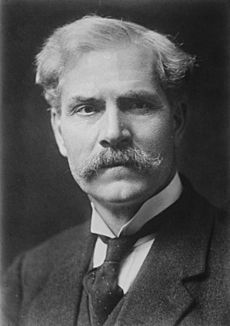
In the 1923 general election, the Conservatives lost their majority. This meant a new government was needed. With the help of the Liberals, Ramsay MacDonald became the first Labour Prime Minister in January 1924. Labour only had 191 MPs, less than a third of Parliament.
The Labour government's biggest success was the Wheatley Housing Act. This started a program to build 500,000 council houses for low-paid workers. They also passed laws on education, unemployment, and tenant protection. Because they needed Liberal support, they could not do everything they wanted, like nationalising the coal industry. But Labour showed they could govern.
The government lasted only ten months. It fell when the Liberals voted against them. In the 1924 general election, a fake letter called the Zinoviev letter was published. It claimed Moscow wanted a Communist revolution in Britain. This letter did not hurt Labour's votes much. But the Liberal party lost many votes, which helped the Conservatives win.
While in opposition, MacDonald continued to present Labour as a moderate party. Labour leaders opposed the 1926 general strike. They believed social changes should happen through voting, not strikes. They were also worried about Communist influence.
Labour's Second Government (1929–1931)
In the 1929 general election, Labour became the largest party in Parliament for the first time. They won 287 seats. But MacDonald still needed Liberal support to form a minority government. MacDonald appointed Margaret Bondfield as the first woman cabinet minister.
MacDonald's second government was stronger than his first. In 1930, Labour passed laws to increase unemployment pay. They also improved wages in the coal industry and passed a housing act to clear slums.
However, the government soon faced a big problem. The Wall Street Crash of 1929 and the Great Depression hit Britain hard. By the end of 1930, unemployment had doubled to over two and a half million. The government struggled to find solutions. By 1931, there were fears about the budget. A report showed the budget was unbalanced. This caused a financial crisis.
The cabinet could not agree on how to respond. Many members did not want to cut unemployment benefits. On August 24, 1931, the government resigned. King George V asked MacDonald to form a National Government with members from all parties. MacDonald agreed. This made many Labour members angry. They felt betrayed. The Labour Party officially rejected the new government. They expelled MacDonald and his supporters. Arthur Henderson became the new leader of the Labour Party.
Henderson led Labour into the 1931 general election against the National Government. It was a disaster for Labour. They won only 52 seats. The Conservative-led National Government won a huge victory. Labour had campaigned against public spending cuts. But it was hard to defend their previous government's actions. Many of the cuts had been agreed before the government fell.
Labour in Opposition (1931–1940)
Arthur Henderson lost his seat in the 1931 election. So, George Lansbury, a pacifist, became the new leader. He was the only former Labour cabinet member who kept his seat.
The party faced another split in 1932. The Independent Labour Party left Labour. This group had disagreed with Labour's leaders for some time.
Lansbury resigned as leader in 1935 due to disagreements over foreign policy. Clement Attlee became the new leader. He would lead the party for twenty years. Labour improved in the 1935 general election. They won 154 seats and 38% of the votes.
As the threat from Nazi Germany grew, Labour slowly changed its mind about peace. By the late 1930s, they supported preparing for war. This was mainly due to Ernest Bevin and Hugh Dalton. By 1937, they had also convinced the party to oppose Neville Chamberlain's policy of trying to avoid war by giving in to demands.
Working Together During Wartime (1940–1945)
Labour joined the government again in 1940. This was part of the wartime coalition. When Neville Chamberlain resigned, Winston Churchill became Prime Minister. He decided to bring other main parties into a government together. Clement Attlee became the first Deputy Prime Minister.
Other important Labour figures also took on big roles. Ernest Bevin managed Britain's wartime economy. Herbert Morrison became Home Secretary.
The Attlee Government (1945–1951)
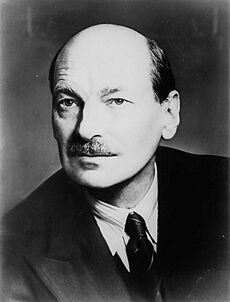
At the end of the war in Europe in May 1945, Labour left the government. They wanted to fight the 1945 general election against Churchill's Conservatives. Labour won a huge victory. They got almost 50% of the votes and a majority of 159 seats.
Attlee's government made many big changes. They used Keynesian economic ideas. They took control of major industries and services. These included the Bank of England, coal mining, steel, electricity, gas, and transport. They also created the "cradle to grave" welfare state. This was based on ideas from William Beveridge.
The most famous achievement was the creation of Britain's National Health Service (NHS) in 1948. This gave free medical treatment to everyone. Aneurin Bevan was the health minister who made this happen. Attlee's government also started ending the British Empire. They gave independence to India and Pakistan in 1947. Burma and Ceylon followed in 1948. In 1947, Attlee's government secretly decided to develop Britain's nuclear weapons. This was against the views of many in the Labour Party.
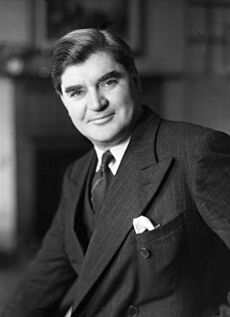
Labour won the 1950 general election again. But their majority was much smaller, only five seats. Soon after, defence spending became a problem. It was very high because of the Korean War. This put a strain on public money. The Chancellor, Hugh Gaitskell, introduced charges for NHS dentures and glasses. Because of this, Bevan and Harold Wilson resigned. They believed healthcare should be completely free.
In the 1951 general election, Labour lost to Churchill's Conservatives. This happened even though Labour got more votes than any other party. Most of the changes made by the 1945–51 Labour government were kept by the Conservatives. This led to a "post-war consensus" that lasted until the late 1970s.
After the War: Labour in Opposition (1951–1964)
After losing in 1951, Labour was out of government for 13 years. The party was split between the left-wing followers of Aneurin Bevan (called Bevanites) and the right-wing followers of Hugh Gaitskell (called Gaitskellites). Also, the economy was doing well, and people were happy with the Conservative governments.
Clement Attlee fought his last election in 1955. Labour lost ground, and he retired soon after. Under the new leader, Hugh Gaitskell, Labour seemed more united. They were expected to win the 1959 general election, but they did not. After this, arguments started again within the party. These were about nuclear disarmament, joining the European Economic Community (EEC), and Clause IV. Clause IV was about nationalising industries, and Gaitskell wanted to remove it. These issues would divide the party for many years.
Gaitskell died suddenly in 1963. Harold Wilson then became the party leader.
The Wilson Government (1964–1970)
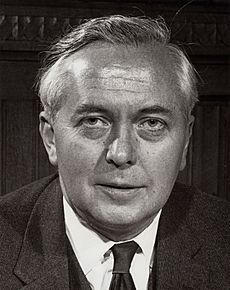
By 1963, the Conservative government was facing economic problems and scandals. The Labour Party returned to government under Wilson in the 1964 general election. They had a small majority of 4 seats. This increased to 96 seats in the 1966 general election.
Wilson's government made many social and education changes. These included ending theatre censorship in 1968. They also focused on expanding education. Comprehensive education grew, and the Open University was created.
Wilson's first time as Prime Minister had low unemployment and a good economy. But there were big problems with a trade deficit. The government spent three years trying to stop the value of the pound from falling. Labour unexpectedly lost the 1970 general election to the Conservatives.
Labour in Opposition (1970–1974)
After losing the 1970 election, Labour was back in opposition. But Harold Wilson remained leader. The Conservative government soon faced problems in Northern Ireland. They also had a dispute with miners in 1973. This led to the "three-day week" where electricity was limited. The 1970s were tough for both parties in government. This was because of the 1973 oil crisis, which caused high prices and a global economic slowdown.
Labour returned to power under Wilson a few days after the February 1974 general election. They formed a minority government. The Conservatives could not form a government alone. To gain a majority, a second election was called in October 1974. Labour, still led by Harold Wilson, won a small majority of three seats.
From Majority to Minority (1974–1979)
For most of its time in office, the Labour government struggled with economic problems. They also had a small majority in Parliament. There were disagreements within the party about Britain joining the European Economic Community. This led to a national vote in 1975. Two-thirds of people voted to stay in. Harold Wilson's popularity was still quite high. But he unexpectedly resigned as Prime Minister in 1976 due to health reasons. James Callaghan replaced him.
The Wilson and Callaghan governments tried to control rising prices. They used a policy of limiting wage increases. This worked quite well, bringing inflation down. But it caused problems between the government and trade unions.
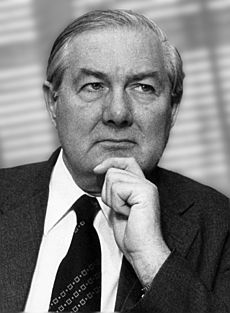
By 1977, Labour lost some by-elections. This meant Callaghan was leading a minority government. He had to make deals with smaller parties to stay in power. An agreement with the Liberal leader David Steel ended after one year. Then, deals were made with the Scottish National Party (SNP) and the Welsh party Plaid Cymru. This kept the government going.
These smaller parties wanted more power for Scotland and Wales. When votes were held in March 1979, Wales voted against more power. Scotland voted for it, but not enough people voted for it to pass. When Labour refused to set up the Scottish Assembly, the SNP stopped supporting the government. This led to a vote of no confidence. Callaghan's government lost by one vote on March 28, 1979. This meant a general election had to be called.
By 1978, the economy was improving. Prices were falling, unemployment was down, and living standards were rising. Labour's poll numbers also improved. Callaghan was expected to call an election in autumn 1978. But he decided to wait. He hoped the economy would be even better in 1979. However, this upset trade unions. During the winter of 1978–79, there were many strikes. These caused big problems for daily life. This time became known as the "Winter of Discontent".
These strikes helped the Conservatives, now led by Margaret Thatcher. Labour lost the 1979 general election. Labour's vote numbers stayed similar to 1974. But the Conservatives gained a lot of support in other areas.
Opposition and Internal Challenges (1979–1994)
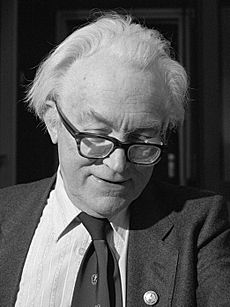
After losing in 1979, the Labour Party had internal arguments. These were between the left-wing, led by Tony Benn, and the right-wing, led by Denis Healey. Michael Foot became leader in 1980. His left-leaning policies, like wanting to leave the European Economic Community, led to four former cabinet ministers leaving. They formed the Social Democratic Party in 1981.
The Labour Party lost badly in the 1983 general election. They won only 27.6% of the vote. This was their lowest share since 1918.

Michael Foot resigned. Neil Kinnock became the new leader. He started to change unpopular policies. The miners' strike of 1984–85 caused divisions within the party.
Labour did better in the 1987 election. They gained 20 seats. This reduced the Conservative majority. They were now clearly the second main political party. The Social Democratic Party merged with the Liberals to form the Liberal Democrats.
In November 1990, Margaret Thatcher resigned as Conservative leader. John Major became Prime Minister. Labour had been ahead in the polls for over a year. This was because of Thatcher's unpopular poll tax and a slowing economy. The change in Conservative leader helped them. But Labour still had a strong lead in the polls.
The 1992 general election was expected to be very close. But the Conservatives won again, though with a smaller majority. This was disappointing for Labour. People started to wonder if Labour could ever win an election again.
Kinnock resigned. John Smith became leader. The debate continued between the old ways and "modernisers." Tony Blair, a "moderniser," argued that the party needed to change. He felt Labour was too focused on the working class and trade unions. He believed they needed to appeal to the growing middle class. Blair and the modernisers wanted to change Clause IV, which was about nationalising industries. This change happened in 1995.
A financial event in September 1992, called Black Wednesday, hurt the Conservative government's reputation. Labour's lead in the polls grew strong. Even when the economy improved, Labour stayed ahead. However, John Smith died suddenly in May 1994.
New Labour Era (1994–2010)
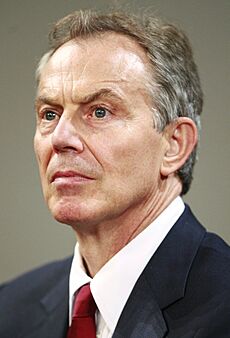
Tony Blair continued to move the party towards the political middle. He removed the old Clause Four in 1995. This was to make the party more appealing to a wider range of voters. This approach was called the Third Way.
The term "New Labour" was first used in 1994. It was a new way to present the Labour Party. It showed a continuation of changes that started under Neil Kinnock. "New Labour" is not an official name. But it is used to tell the difference between modernisers and those with more traditional views.
New Labour is a party of ideas and ideals but not of outdated ideology. What counts is what works. The objectives are radical. The means will be modern.
The Labour Party won the 1997 general election by a huge amount. They had a majority of 179 seats. This was Labour's largest ever majority. Over the next ten years, many social changes were made. Millions of people were helped out of poverty.
Early actions of Blair's government included setting up the national minimum wage. They also gave more power to Scotland, Wales, and Northern Ireland. They changed how banks were regulated. And they created a new government body for London, the Greater London Authority, with its own elected Mayor.
Labour won the 2001 election with a similar majority. This was called the "quiet landslide." In 2003, Labour introduced tax credits. These were government payments to top up the wages of low-paid workers.
A turning point was when Blair supported US President George W. Bush in the Iraq War. This caused him to lose a lot of support. The UN Secretary-General and many others thought the war was against international law. The war was very unpopular in many countries. The decisions leading to the Iraq war were investigated in the Iraq Inquiry.
In the 2005 general election, Labour won a third term. But their majority was smaller, 66 seats. Their popular vote was only 35.2%. This was the lowest percentage for any majority government in British history.
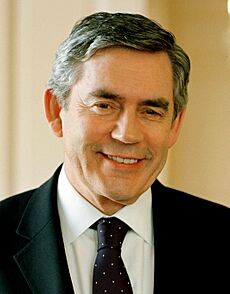
Blair announced in September 2006 that he would resign within a year. He was under pressure to leave earlier. In 2007, Labour lost power in Scotland. Shortly after, Blair resigned. Gordon Brown, the Chancellor, replaced him. The party's popularity briefly rose, then fell to its lowest level since the 1980s. In May 2008, Labour lost badly in local elections and the London mayoral election. Many people blamed Brown's leadership. Brown managed the UK's response to the 2007–2008 financial crisis. Party membership also fell to a low point.
Funding was a big problem for Labour during this time. A "cash for peerages" issue under Blair meant fewer big donations. By 2008, Labour was £17 million in debt. This debt grew to £24.5 million but was paid off by 2015.
In the 2010 general election on May 6, Labour won 258 seats. The Conservatives won 307 seats. No party had a clear majority. This meant Labour could still stay in power if they formed a coalition. But they would need more than one small party. On May 10, 2010, talks with the Liberal Democrats failed. Brown announced he would step down as leader. The next day, he resigned as both Prime Minister and party leader.
Opposition and Recent Challenges (2010–Present)
Ed Miliband's Leadership (2010–2015)
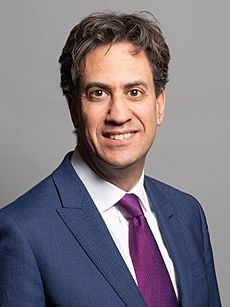
Harriet Harman became the interim leader after Gordon Brown resigned. Ed Miliband won the leadership election. Miliband focused on "responsible capitalism." He wanted more government involvement to balance the economy. He called for more rules for banks and energy companies. He also talked about challenging powerful groups and making society more inclusive. In 2012, he used the slogan "One Nation Labour."
In 2011, Labour MPs voted to stop holding elections for the Shadow Cabinet. From then on, the party leader chose the Shadow Cabinet members.
Labour did well in the 2012 local elections. They gained ground in England and Wales. In March 2014, the party changed how its internal elections worked. They moved to a "one member, one vote" system. This encouraged more people to join. Trade union members also had to specifically agree to pay a political fee to the party.
In the 2014 European Parliament election, Labour won 20 seats. They also gained 324 local councillors. In September 2014, Labour planned to cut the government's deficit by 2020. They took these plans into the 2015 general election. Labour lost this election. Their seats fell to 232. They lost 40 of their 41 seats in Scotland.
Jeremy Corbyn's Leadership (2015–2020)
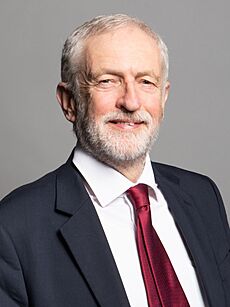
After the 2015 election, Miliband resigned. Harriet Harman became interim leader again. In the leadership election, Jeremy Corbyn was seen as an outsider. But he won with 60% of the vote. Many new members joined Labour during this election. After his win, membership kept growing. A year later, it was over 500,000. This made Labour the largest political party in Western Europe.
Brexit Referendum
Soon, there were tensions among Labour MPs about Corbyn's leadership. This was especially after the 2016 Brexit referendum. Many in the party were angry that Corbyn did not campaign strongly against Brexit. He was only a "lukewarm" supporter of staying in the European Union. 21 members of his Shadow Cabinet resigned after the vote. Corbyn lost a no-confidence vote among Labour MPs. This led to another leadership election, which he won with 62% support.
2017 General Election
In April 2017, Prime Minister Theresa May called an early election. Corbyn focused on healthcare, education, and ending austerity. Labour started the campaign far behind in the polls. But they surprised everyone by getting 40% of the vote. This was their biggest increase in vote share since 1945. The party gained 30 seats.
Accusations of Antisemitism
From 2016, the Labour Party faced criticism for not dealing with antisemitism. The Chakrabarti Inquiry found an "occasionally toxic atmosphere" but no widespread antisemitism. Some high-profile party members left or were suspended over antisemitism-related issues. In 2018, there were disagreements about adopting a specific definition of antisemitism. The issue was mentioned by some MPs who left the party to form Change UK. During the 2019 election, the Chief Rabbi accused Labour of allowing antisemitism. An investigation by the Equalities and Human Rights Commission found the party responsible for three breaches of the Equality Act.
2019 General Election
In February 2019, seven Labour MPs left the party. They formed The Independent Group (later Change UK). This was partly due to Labour's position on Brexit. A week later, Labour's leadership said they would support another referendum "as a final resort."
During the 2019 general election, Labour campaigned on a very radical plan. It included plans to take control of major energy firms, the National Grid, water industry, Royal Mail, railways, and BT's broadband. Over 160 economists supported Labour's spending plans.
The election resulted in Labour winning its lowest number of seats since 1935. A review after the election suggested that Jeremy Corbyn's declining popularity was a reason for the loss. This was linked to the Brexit position and antisemitism claims.
Keir Starmer's Leadership (2020–Present)
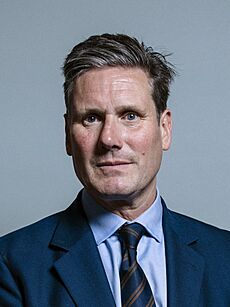
After Labour's defeat in the 2019 general election, Jeremy Corbyn announced he would step down. On April 4, 2020, Keir Starmer was elected as Leader of the Labour Party.
One of Starmer's first goals was to address the antisemitism accusations. In 2020, the Equalities and Human Rights Commission (EHRC) found Labour guilty of three breaches of the Equality Act. The party temporarily suspended former leader Jeremy Corbyn. This was after he said the problem was "overstated for political reasons." The party later allowed him back as a member. But in 2023, they stopped him from running as a Labour candidate again. In February 2023, the EHRC stopped monitoring the party.
Starmer's time as leader has seen the party move closer to the political centre. He has faced claims of being too strict. Some say he has removed left-wing candidates and suspended two left-wing MPs. Since late 2021, Labour has been ahead of the Conservatives in opinion polls. This includes their highest lead in over 20 years during the government crisis in 2022.
What Labour Believes In
In 2015, Labour was seen as a centre-left party. It was created to give a voice to the trade union movement in Parliament. Labour became a socialist party with its 1918 rules. Clause IV called for "common ownership" or nationalisation of industries. After World War II, about a third of British industry was publicly owned. But by the late 1950s, some in the party questioned this.
Historically, Labour believed in government intervention in the economy. They also supported sharing wealth more evenly. Taxation was seen as a way to achieve this. The party also wanted more rights for workers and a welfare state with publicly funded healthcare.
From the late 1980s, the party adopted more free market ideas. This led many to describe Labour as social democratic or following the Third Way. This was different from being purely democratic socialist. Some say this shift has changed Labour's relationship with trade unions.
The new version of Clause IV still supports democratic socialism. But it no longer strictly commits the party to public ownership. Instead, it talks about "the enterprise of the market" and "high quality public services." Within the party, there are different groups. The Socialist Campaign Group represents a more radical socialist view. Groups like Compass represent the social democratic view. Progress was a centrist group. Momentum was created in 2015 as a left-wing group for ordinary members. The party also has a Christian socialist group called Christians on the Left.
Symbols of the Party
Labour has long been linked with the colour red. Red is a political colour often used by socialist and labour movements. Before the red flag, the party used a logo with a shovel, torch, and quill. In 1924, a competition was held to design a new logo. The winning design had the word "Liberty" and the shovel, torch, and quill symbols. In 1931, the party decided its colours should be red and gold. During the New Labour period, purple was also used.
Since it started, the red flag has been Labour's official symbol. The flag has been linked to socialism and revolution since the 1789 French Revolution. The red rose is a symbol of socialism. It was adopted as the party symbol in 1986. It is now part of the party logo.
The red flag inspired the song "The Red Flag." This has been the official party anthem since the beginning. It is sung at the end of party conferences. The song "Jerusalem" is also traditionally sung at the end of conferences.
How Labour is Organized
The Labour Party is made up of individual members and local groups. It also includes affiliated trade unions, socialist societies, and the Co-operative Party. The Co-operative Party has an agreement to work with Labour in elections. Members who are elected to Parliament form the Parliamentary Labour Party (PLP). Before Brexit in January 2020, members also took part in the European Parliament.
The main decision-making bodies are the National Executive Committee (NEC), Labour Party Conference, and National Policy Forum (NPF). However, the leaders in Parliament usually have the final say on policy. Since 2008, the party conference has focused more on speeches and Q&A sessions. Policy discussions now happen in the National Policy Forum.
The Labour Party is a group without a separate legal identity. Its rules are in the Labour Party Rule Book. The General Secretary represents the party in legal matters.
Members and Supporters
In December 2010, Labour had 193,261 individual members. This was a historic low. Membership stayed about the same for a few years. In August 2015, before the 2015 leadership election, Labour had about 550,000 members and supporters.
After Jeremy Corbyn was elected leader, individual membership almost doubled. It reached 388,262 in December 2015. It rose again to 543,645 in December 2016. As of December 2017, the party had 564,443 members. This was the highest since 1980. It made Labour the largest political party in Western Europe. Membership fees became the party's biggest source of income. By December 2019, the party had 532,046 members.
In the 2020 leadership election, 490,731 people voted. Most were full members. The "registered supporter" category was removed in 2021. By July 2023, membership had fallen to 399,195. In March 2024, it was 366,604.
Northern Ireland
For many years, Labour did not allow people in Northern Ireland to join. Instead, they supported the Social Democratic and Labour Party (SDLP). The SDLP often votes with Labour in Parliament. In 2003, the Labour Party Conference agreed that they could not stop people from joining. The party has set up a branch there. But it has not yet agreed to run in elections in Northern Ireland.
Link to Trade Unions
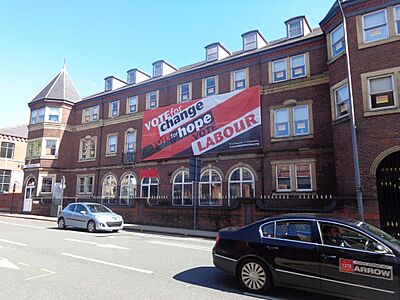
Labour was founded by unions to represent working-class people. So, its link with unions has always been very important. Recently, this link has faced challenges. The RMT was expelled in 2004. This was because its Scottish branches joined another left-wing party. Other unions have also considered reducing their financial support for Labour. This is due to disagreements over issues like privatisation and public spending cuts. Union funding rules were changed in 2013. The Fire Brigades Union rejoined Labour in 2015.
European and International Connections
The Labour Party helped start the Party of European Socialists (PES). Before Brexit, Labour's 10 Members of the European Parliament (MEPs) were part of the Socialists and Democrats group. This was the second-largest group in the European Parliament.
Since 1951, Labour has been a member of the Socialist International. This group was founded with the help of Clement Attlee. In 2013, Labour decided to become an observer member. This was due to "ethical concerns." Labour also helped found the Progressive Alliance in 2013. This is an international group of social-democratic parties.
Election Results
For all detailed election results involving the Labour Party, including general elections, devolved national elections, London Assembly, London Mayoral, combined authority and European Parliament elections, see: Electoral history of the Labour Party (UK).
Since the 1922 general election, Labour has always been either the governing party or the main opposition.
UK General Election Results
After the 1918 general election, Labour became the main opposition. This was after the Conservatives formed a government with the Liberal Party. Labour's first minority governments were after the 1923 and 1929 elections. The 1929 election was the first time Labour won the most seats. They formed their first majority government after the 1945 general election.
After winning the 1950 general election, Labour lost the next election in 1951. This happened even though they got their highest share of votes ever at 48.8%. In the 1983 election, Labour had their worst vote share since World War II, at 27.6%. In 1997, a record 418 Labour MPs were elected. In the 2019 general election, 202 Labour MPs were elected. This was the lowest for the party since 1935. Since the 2010 general election, Labour has lost four general elections in a row. The next general election is on July 4, 2024.
| Election | Leader | Votes | Seats | Position | Result | Ref | |||
|---|---|---|---|---|---|---|---|---|---|
| No. | Share | No. | ± | Share | |||||
| 1900 | Keir Hardie | 62,698 | 1.8 |
2 / 670
|
0.3 | 4th | Conservative–Liberal Unionist | ||
| 1906 | 321,663 | 5.7 |
29 / 670
|
4.3 | Liberal | ||||
| January 1910 | Arthur Henderson | 505,657 | 7.6 |
40 / 670
|
6.0 | Liberal minority | |||
| December 1910 | George Nicoll Barnes | 371,802 | 7.1 |
42 / 670
|
6.3 | Liberal minority | |||
| 1918 | William Adamson | 2,245,777 | 20.8 |
57 / 707
|
8.1 | Coalition Liberal–Conservative | |||
| 1922 | J. R. Clynes | 4,237,349 | 29.7 |
142 / 615
|
23.1 | Conservative | |||
| 1923 | Ramsay MacDonald | 4,439,780 | 30.7 |
191 / 615
|
30.1 | Labour minority | |||
| 1924 | 5,489,087 | 33.3 |
151 / 615
|
24.6 | Conservative | ||||
| 1929 | 8,370,417 | 37.1 |
287 / 615
|
47.0 | Labour minority | ||||
| 1931 | Arthur Henderson | 6,649,630 | 30.9 |
52 / 615
|
8.5 | Conservative–Liberal–National Labour | |||
| 1935 | Clement Attlee | 8,325,491 | 38.0 |
154 / 615
|
25.0 | Conservative–Liberal National–National Labour | |||
| 1945 | 11,967,746 | 48.0 |
393 / 640
|
61.0 | Labour | ||||
| 1950 | 13,266,176 | 46.1 |
315 / 625
|
50.4 | Labour | ||||
| 1951 | 13,948,883 | 48.8 |
295 / 625
|
47.2 | Conservative | ||||
| 1955 | 12,405,254 | 46.4 |
277 / 630
|
44.0 | Conservative | ||||
| 1959 | Hugh Gaitskell | 12,216,172 | 43.8 |
258 / 630
|
40.1 | Conservative | |||
| 1964 | Harold Wilson | 12,205,808 | 44.1 |
317 / 630
|
50.3 | Labour | |||
| 1966 | 13,096,629 | 48.0 |
364 / 630
|
57.8 | Labour | ||||
| 1970 | 12,208,758 | 43.1 |
288 / 630
|
45.7 | Conservative | ||||
| February 1974 | 11,645,616 | 37.2 |
301 / 635
|
47.4 | Labour minority | ||||
| October 1974 | 11,457,079 | 39.3 |
319 / 635
|
50.2 | Labour | ||||
| 1979 | James Callaghan | 11,532,218 | 36.9 |
269 / 635
|
42.4 | Conservative | |||
| 1983 | Michael Foot | 8,456,934 | 27.6 |
209 / 650
|
32.2 | Conservative | |||
| 1987 | Neil Kinnock | 10,029,807 | 30.8 |
229 / 650
|
35.2 | Conservative | |||
| 1992 | 11,560,484 | 34.4 |
271 / 651
|
41.6 | Conservative | ||||
| 1997 | Tony Blair | 13,518,167 | 43.2 |
418 / 659
|
63.6 | Labour | |||
| 2001 | 10,724,953 | 40.7 |
412 / 659
|
62.7 | Labour | ||||
| 2005 | 9,552,436 | 35.2 |
355 / 646
|
55.0 | Labour | ||||
| 2010 | Gordon Brown | 8,606,517 | 29.0 |
258 / 650
|
40.0 | Conservative–Liberal Democrats | |||
| 2015 | Ed Miliband | 9,347,324 | 30.4 |
232 / 650
|
35.7 | Conservative | |||
| 2017 | Jeremy Corbyn | 12,877,918 | 40.0 |
262 / 650
|
40.3 | Conservative minority (with DUP confidence and supply) |
|||
| 2019 | 10,269,051 | 32.1 |
202 / 650
|
31.1 | Conservative | ||||
- Note
Party Leaders
Leaders of the Labour Party Since 1906
- Keir Hardie (1906–1908)
- Arthur Henderson (1908–1910)
- George Barnes (1910–1911)
- Ramsay MacDonald (1911–1914)
- Arthur Henderson (1914–1917)
- William Adamson (1917–1921)
- J. R. Clynes (1921–1922)
- Ramsay MacDonald (1922–1931)
- Arthur Henderson (1931–1932)
- George Lansbury (1932–1935)
- Clement Attlee (1935–1955)
- Hugh Gaitskell (1955–1963)
- George Brown (1963; acting)
- Harold Wilson (1963–1976)
- James Callaghan (1976–1980)
- Michael Foot (1980–1983)
- Neil Kinnock (1983–1992)
- John Smith (1992–1994)
- Margaret Beckett (1994; acting)
- Tony Blair (1994–2007)
- Gordon Brown (2007–2010)
- Harriet Harman (2010; acting)
- Ed Miliband (2010–2015)
- Harriet Harman (2015; acting)
- Jeremy Corbyn (2015–2020)
- Keir Starmer (2020–present)
Deputy Leaders of the Labour Party Since 1922
- J. R. Clynes (1922–1932)
- William Graham (1931–1932)
- Clement Attlee (1932–1935)
- Arthur Greenwood (1935–1945)
- Herbert Morrison (1945–1956)
- Jim Griffiths (1956–1959)
- Aneurin Bevan (1959–1960)
- George Brown (1960–1970)
- Roy Jenkins (1970–1972)
- Edward Short (1972–1976)
- Michael Foot (1976–1980)
- Denis Healey (1980–1983)
- Roy Hattersley (1983–1992)
- Margaret Beckett (1992–1994)
- John Prescott (1994–2007)
- Harriet Harman (2007–2015)
- Tom Watson (2015–2019)
- Angela Rayner (2020–present)
Labour Prime Ministers
| Name | Portrait | Country of birth | Periods in office |
|---|---|---|---|
| Ramsay MacDonald |  |
Scotland | 1924; 1929–1931 (first and second MacDonald ministries) |
| Clement Attlee |  |
England | 1945–1950; 1950–1951 (Attlee ministry) |
| Harold Wilson |  |
England | 1964–1966; 1966–1970; 1974; 1974–1976 (first, second, third and fourth Wilson ministries) |
| James Callaghan |  |
England | 1976–1979 (Callaghan ministry) |
| Tony Blair |  |
Scotland | 1997–2001; 2001–2005; 2005–2007 (first, second and third Blair ministries) |
| Gordon Brown |  |
Scotland | 2007–2010 (Brown ministry) |
Images for kids
-
Keir Hardie speaking to trade union workers at Trafalgar Square, 1908.
See Also
 In Spanish: Partido Laborista (Reino Unido) para niños
In Spanish: Partido Laborista (Reino Unido) para niños
- Blue Labour
- English Labour Network
- Labour Campaign for Trans Rights
- Labour Representation Committee election results
- List of Labour parties
- List of Labour Party (UK) MPs
- List of organisations associated with the Labour Party (UK)
- List of Labour Party (UK) general election manifestos
- Politics of the United Kingdom
- Socialist Labour Party (UK)
- Socialist Party (England and Wales)


